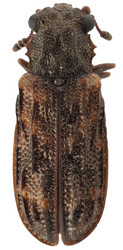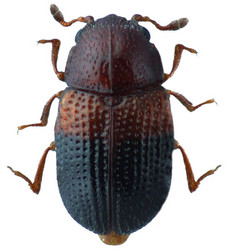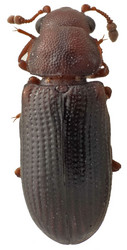Sphindidae
Cryptic slime mold beetles
Joseph V. McHugh and Juanita Forrester


This tree diagram shows the relationships between several groups of organisms.
The root of the current tree connects the organisms featured in this tree to their containing group and the rest of the Tree of Life. The basal branching point in the tree represents the ancestor of the other groups in the tree. This ancestor diversified over time into several descendent subgroups, which are represented as internal nodes and terminal taxa to the right.

You can click on the root to travel down the Tree of Life all the way to the root of all Life, and you can click on the names of descendent subgroups to travel up the Tree of Life all the way to individual species.
For more information on ToL tree formatting, please see Interpreting the Tree or Classification. To learn more about phylogenetic trees, please visit our Phylogenetic Biology pages.
close boxIntroduction
The family Sphindidae, commonly known as the Cryptic Slime Mold Beetles, comprises 67 species divided among 9 genera and 4 subfamilies. Sphindidae is represented in all major zoogeographic regions. All known species are myxomycophagous (eat slime molds).
Characteristics
Adult sphindids are small (1.5-3.5 mm), elongate oval to subhemispherical beetles. The coloration is typically monochromatic and drab, often castaneous or piceous; however, the elytra may be bicolored in some genera (e.g., Notosphindus, Sphindus, Carinisphindus). The vestiture is usually sparse and suberect, but may be dense and erect in some Eurysphindus and Aspidiphorus species. Most adults of this family can be diagnosed with the following suite of features:
- Antenna with 10-11 articles
- Scape and pedicel asymmetrically inflated for apical 1/2 to 2/3
- Antennal club abrupt, 2-3 segmented, densely pubescent
- Mandible with large dorsal tubercle and setose cavity
- Coxae transverse
- Tarsi simple, usually 5-5-5 female and 5-5-4 male
- Elytral punctures usually seriate
Mature larvae are 1.5 to 5 mm long, elongate to fusiform and slightly compressed. The head is dark and abdominal terga are often weakly pigmented (e.g., Odontosphindus, Carinisphindus, Sphindus) or are uniformly pale (e.g., Eurysphindus, Genisphindus). The integument is smooth or bears granules or asperities, especially on terga. The vestiture is sparse to moderately dense. The setae are usually long and simple, but may be capitate or spiraled at the apex (e.g., Notosphindus, Eurysphindus). Most sphindid larvae can be diagnosed with the following combination of characters:
- Head protracted and prognathous
- Frontal arms lyriform and basally contiguous
- Endocarina absent
- Frontoclypeal suture absent
- Labrum free
- Stemmata six per side
- Antenna 3-segmented with antennomere 2 longest
- Mandible with ventral accessory process and large mola
- Maxillolabial complex retracted
- Mala broadly rounded, setose, with 2-3 small teeth near apex
- Hypopharyngeal sclerome forming transverse bar
- Thoracic spiracles annular or annular uniforous, situated at end of short tubes
- Abdomen 10-segmented with paired tergal plates on segments I-VIII
Biology
One of the diagnostic characteristics of Sphindidae is the cavity on the dorsal surface of the adult mandible, which Crowson (1981) suggests functions as a mycangium. Sphindids possess many potentially mycangial punctures and depressions which carry myxomycete spores, but it is unclear if there are any specialized glands associated with these structures that facilitate the process (McHugh & Wheeler 1991; McHugh 1993).
Sphindids occur in most habitats that foster myxomycete growth, especially moist areas with abundant decaying organic matter. All life stages typically remain on or near their myxomycete host. Adults, however, may hibernate under loose bark, in crevices of wood, or in leaf litter (Burakowski & Ślipiński 1987). Females oviposit directly on myxomycete fruiting bodies. The incubation period for sphindid eggs is approximately three days. Sphindid larvae live on slime mold sporocarps and have four instars. Mature larvae use an anal secretion to secure themselves to the substrate before pupation. The entire developmental cycle lasts from 20 to 30 days.
Relationship of Sphindidae to Other Cucujoidea
Although no unambiguous morphological synapomorphy is known for Sphindidae, the family is considered monophyletic based on a suite of anatomical features (see above). Myxomycophagy could be considered an additional synapomorphy for the family.
Sen Gupta & Crowson (1977) hypothesized that Sphindidae represented a basal branch of Cucujoidea, closely related to Phloeostichidae, Silvanidae, Boganiidae and Protocucujidae. Multiple studies (McHugh 1993; Chiao and McHugh 2000; Ślipiński 1998; Leschen et al. 2005) supported a close relationship between Protocucujidae and Sphindidae. Recently, however, the phylogenetic position of the family was brought into question by the findings of a molecular phylogenetic study (Hunt et al. 2007) which suggested that Sphindidae is not positioned among the basal clades of Cucujoidea. Instead these new findings indicate a sister group relationship between Sphindidae and a clade comprising Tenebrionoidea and Lymexyloidea. Additional study is needed to resolve this issue.
Taxonomy
The classification scheme of Sengupta and Crowson (1977) divided Sphindidae into four subfamilies: Protosphindinae, Sphindinae, Eurysphindinae, and Aspidiphorinae. According to their arrangement, Protosphindinae comprised the single genus, Protosphindus. Eurysphindinae also was monotypic, including only Eurysphindus. Sphindinae comprised Sphindus and Odontosphindus, and Aspidiphorinae included Sphindiphorus and Aspidiphorus. McHugh (1993) conducted a phylogenetic study of the family based on adult morphology and proposed modifications of the classification. Under this new scheme, Protosphindinae, Odontosphindinae, and Sphindiphorinae each became monogeneric subfamilies. Eurysphindus, Aspidiphorus, and Sphindus were placed in Sphindinae, along with two genera, Genisphindus and Carinisphindus, that were established after the publication of Sengupta and Crowson’s classification. This revised classification was supported by a phylogenetic study of adult and larval characters by Chiao and McHugh (2000) which also established the placement of Notosphindus in Sphindinae.
Other Names for Sphindidae
- Aspidiphoridae
- Coniporidae
- Vernacular Names: Cryptic slime mold beetles, Dry fungus beetles
References
Arnett, R.H., Jr. 1963. The Beetles of the United States. Catholic University of America Press, Washington, D. C.
Benick, L. 1952. Pilzkäfer und Käferpilze. Acta Zoologica Fennica 70: 1-250.
Burakowski, B. and S.A. Ślipiński. 1987. A new species of Protosphindus (Coleoptera: Sphindidae) from Chile with notes and descriptions of immature stages of related forms. Annali del Museo Civico di Storia Naturale, Genova 86: 605-625.
Chiao, E. and J.V. McHugh. 2000. Larval Sphindidae (Coleoptera: Cucujoidea): Phylogenetic implications and new descriptions. Invertebrate Taxonomy 14(6): 807-824.
Crowson, R.A. 1967. The Natural Classification of the Families of Coleoptera. 202 pp. E. W. Classey Ltd., Middlesex.
Crowson, R.A. 1981. The Biology of the Coleoptera. 802 pp. Academic Press, London.
Dejean, P.F.M.A. 1821. Catalogue de la Collection de Coléoptères de M. le baron Dejean. Crevot, Paris, 136 pp.
Forrester, J. and J.V. McHugh. Sphindidae, Jacquelin du Val, 1861. In: Beutel, R.G. and R.A.B. Leschen (eds.) Handbuch der Zoologie. Band IV, Teilband 38, vol. 2. De Gruyter, Berlin. In press.
Hunt, T., J. Bergsten, Z. Levkanicova, A. Papadopoulou, O. St John, R. Wild, P.M. Hammond, D. Ahrens, M. Balke, M.S. Caterino, J. Gómez-Zurita, I. Ribera, T.G. Barraclough, M. Bocakova, L. Bocak, and A.P. Vogler. 2007. A comprehensive phylogeny of beetles reveals the evolutionary origins of a super-radiation. Science 318: 1913-1916.
Lawrence, J.F. 1989. Mycophagy in the Coleoptera: feeding strategies and morphological adaptations. In: Wilding, N., Collins, N.M., Hammond, P.M., & Webber, J.F. (eds.) Insect – Fungus Interactions. Academic Press, London. 344 pp.
Lawrence, J.F. 1991. Coleoptera. Sphindidae. In: Stehr, F.W. (ed.) Immature Insects. Vol. 2. Kendall Hunt, Dubuque. 975 pp.
Lawrence, J.F. and A.F. Newton. 1980. Coleoptera associated with the fruiting bodies of slime molds (Myxomycetes). The Coleopterists’ Bulletin 34(2): 129-143.
LeConte, J.L. 1866. New species of North American Coleoptera. Smithsonian Miscellaneous Collections 167: 87-177.
LeConte, J.L. 1878. The Coleoptera of Michigan. Proceedings of the American Philosophical Society, 17, 593-626.
Leschen, R.A.B., J.F. Lawrence and S.A. Ślipiński. 2005. Classification of basal Cucujoidea (Coleoptera: Polyphaga): cladistic analysis, keys and review of new families. Invertebrate Systematics 19: 17-73.
McHugh, J.V. 1990. Carinisphindus, a new genus and three new species of Neotropical Sphindidae (Coleoptera: Clavicornia). The Coleopterists’ Bulletin 44(3): 307-322.
McHugh, J.V. 1993. A revision of Eurysphindus LeConte (Coleoptera: Cucujoidea: Sphindidae) and a review of sphindid classification and phylogeny. Systematic Entomology 18: 57-92.
McHugh, J.V. 2002. Sphindidae (Jacquelin du Val, 1861): The Cryptic Slime Mold Beetles. In: Arnett, R., Jr, M. Thomas, P. Skelley, and J.H. Frank (eds.) American Beetles. Volume 2. Sandhill Crane Press, Gainesville. 861 pp.
McHugh, J.V. and T.G. Kiselyova. 2003. First descriptions for larval stages of Eurysphindus (Coleoptera: Cucujoidea: Sphindidae). The Coleopterists’ Bulletin 57(1): 17-25.
McHugh, J.V. and Q.D. Wheeler. 1991. Notosphindus slateri, a new genus and species of Australian Sphindidae. Journal of the New York Entomological Society 99(3): 527-537.
Russell, L.K. 1979. Beetles associated with slime molds (Mycetozoa) in Oregon and California (Coleoptera: Leiodidae, Sphindidae, Lathridiidae). The Pan-Pacific Entomologist 55: 1-9.
Sen Gupta, T. and R.A. Crowson. 1977. The coleopteran family Sphindidae. The Entomologist’s Monthly Magazine 113: 177-191.
Ślipiński, S.A. 1998. Revision and phylogeny of Protocucujidae (Coleoptera, Cucujoidea). Annales Zoologici 48: 275-298.
Stephenson, S.L., Q.D. Wheeler, J.V. McHugh, and P.R. Frassinet. 1994. New North American associations of Coleoptera with Myxomycetes. Journal of Natural History 28: 921-936.
Title Illustrations

| Scientific Name | Protosphindus chilensis |
|---|---|
| Specimen Condition | Dead Specimen |
| Identified By | Joseph V. McHugh |
| Life Cycle Stage | Adult |
| View | Dorsal |
| Image Use |
 This media file is licensed under the Creative Commons Attribution-NonCommercial License - Version 3.0. This media file is licensed under the Creative Commons Attribution-NonCommercial License - Version 3.0.
|
| Copyright | © 2010 |
| Scientific Name | Carinisphindus purpuricephalus |
|---|---|
| Specimen Condition | Dead Specimen |
| Identified By | Joseph V. McHugh |
| Life Cycle Stage | Adult |
| View | Dorsal |
| Image Use |
 This media file is licensed under the Creative Commons Attribution-NonCommercial License - Version 3.0. This media file is licensed under the Creative Commons Attribution-NonCommercial License - Version 3.0.
|
| Copyright | © 2010 |
| Scientific Name | Genisphindus sp. |
|---|---|
| Identified By | Joseph V. McHugh |
| Life Cycle Stage | Adult |
| View | Dorsal |
| Image Use |
 This media file is licensed under the Creative Commons Attribution-NonCommercial License - Version 3.0. This media file is licensed under the Creative Commons Attribution-NonCommercial License - Version 3.0.
|
| Copyright | © |
| Scientific Name | Odontosphindus clavicornis |
|---|---|
| Specimen Condition | Dead Specimen |
| Identified By | Joseph V. McHugh |
| Life Cycle Stage | Adult |
| View | Dorsal |
| Image Use |
 This media file is licensed under the Creative Commons Attribution-NonCommercial License - Version 3.0. This media file is licensed under the Creative Commons Attribution-NonCommercial License - Version 3.0.
|
| Copyright | © 2010 |
About This Page
We thank all members of the McHugh lab for their assistance with this project. Support for the construction of this page was provided by an NSF AToL grant EF-0531665 to M.F. Whiting (subcontract to J.V. McHugh) and through an NSF PEET grant (DEB-0329115) to J.V. McHugh, M.F. Whiting, and K.B. Miller.
Joseph V. McHugh

University of Georgia, Athens, Georgia, USA

University of Georgia, Athens, Georgia, USA
Correspondence regarding this page should be directed to Joseph V. McHugh at and Juanita Forrester at
Page copyright © 2010 Joseph V. McHugh and
 Page: Tree of Life
Sphindidae . Cryptic slime mold beetles.
Authored by
Joseph V. McHugh and Juanita Forrester.
The TEXT of this page is licensed under the
Creative Commons Attribution License - Version 3.0. Note that images and other media
featured on this page are each governed by their own license, and they may or may not be available
for reuse. Click on an image or a media link to access the media data window, which provides the
relevant licensing information. For the general terms and conditions of ToL material reuse and
redistribution, please see the Tree of Life Copyright
Policies.
Page: Tree of Life
Sphindidae . Cryptic slime mold beetles.
Authored by
Joseph V. McHugh and Juanita Forrester.
The TEXT of this page is licensed under the
Creative Commons Attribution License - Version 3.0. Note that images and other media
featured on this page are each governed by their own license, and they may or may not be available
for reuse. Click on an image or a media link to access the media data window, which provides the
relevant licensing information. For the general terms and conditions of ToL material reuse and
redistribution, please see the Tree of Life Copyright
Policies.
- First online 26 January 2010
- Content changed 26 January 2010
Citing this page:
McHugh, Joseph V. and Juanita Forrester. 2010. Sphindidae . Cryptic slime mold beetles. Version 26 January 2010 (under construction). http://tolweb.org/Sphindidae/9143/2010.01.26 in The Tree of Life Web Project, http://tolweb.org/













 Go to quick links
Go to quick search
Go to navigation for this section of the ToL site
Go to detailed links for the ToL site
Go to quick links
Go to quick search
Go to navigation for this section of the ToL site
Go to detailed links for the ToL site